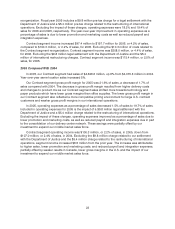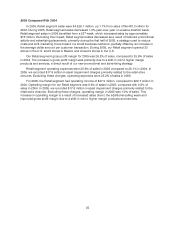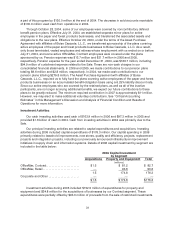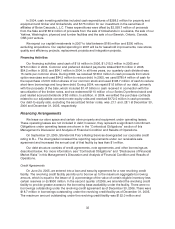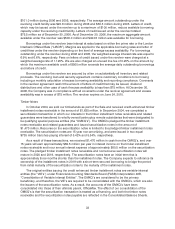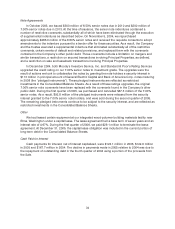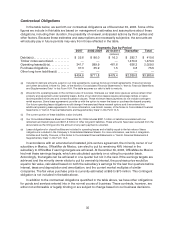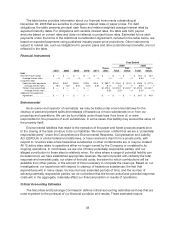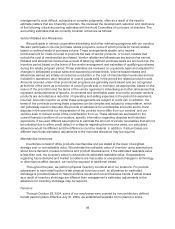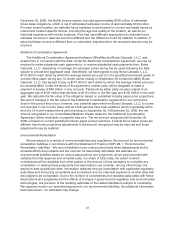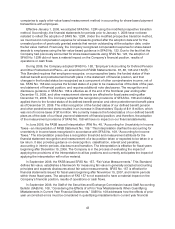OfficeMax 2006 Annual Report Download - page 37
Download and view the complete annual report
Please find page 37 of the 2006 OfficeMax annual report below. You can navigate through the pages in the report by either clicking on the pages listed below, or by using the keyword search tool below to find specific information within the annual report.33
$101.0 million during 2006 and 2005, respectively. The average amount outstanding under the
revolving credit facilitywas $20.6million during 2006 and $30.3 million during 2005. Letters of credit,
which may be issued under the revolver up to amaximum of$100million, reduce available borrowing
capacity under the revolving credit facility. Letters of credit issued under the revolver totaled
$75.5 million as of December 30, 2006. As of December 30,2006, the maximum aggregate amount
available under the revolver was $500.0 million and $424.5 million was available for borrowing.
Borrowings under the revolver bear interest at rates based on either the prime rate or the London
Interbank Offered Rate (“LIBOR”). Margins are applied to the applicable borrowing rates and letter of
credit fees under the revolver depending on the level of average excess availability. For borrowings
outstanding under the revolver during 2006 and 2005, the weighted average interest rate was equal to
6.9% and 6.6%, respectively. Fees onletters of credit issued under the revolver were chargedat a
weighted average rate of1.125%. Weare also charged anunusedline fee of 0.25% on theamount by
which the maximum available credit of $500 million exceeds the average daily outstanding borrowings
and letters of credit.
Borrowings under the revolver are secured by a lien on substantially all inventory and related
proceeds. The revolving loan and security agreement contains customary conditions to borrowing
including amonthly calculation of excess borrowing availability and reporting compliance. Covenants
in the revolver agreement restrict the amount of letters of creditthat may be issued, dividend
distributions and other uses of cash ifexcess availability isless than $75million. At December 30,
2006,the Company was incompliance with all covenants under the revolver agreement and excess
availability was in excess of $75 million. Therevolver expires on June 24, 2010.
Timber Notes
In October 2004, we sold our timberlands as part of the Sale and received credit- enhanced timber
installment notes receivable in the amount of $1,635 million. In December 2004, we completed a
securitization transaction in which our interests in the timber installment notes receivable and related
guarantees were transferred to wholly-owned bankruptcy remote subsidiaries that were designated to
be qualifying special purpose entities (the “OMXQ’s”). The OMXQ’s pledged the timber installment
notes receivable andrelated guarantees and issued securitization notes in the amount of
$1,470 million. Recourse on the securitization notesis limited to the pledged timber installment notes
receivable. The securitization notes are 15-year non-amortizing, and were issued in two equal
$735 million tranches paying interest of 5.42% and 5.54%, respectively.
As a result ofthese transactions, we received $1,470 millionin cash from the OMXQ’s, and over
15 yearswill earn approximately $82.5 million per year ininterest income on the timber installment
notes receivable and incur annual interest expense of approximately $80.5 million onthe securitization
notes. The pledged timber installment notes receivable and nonrecourse securitization notes will
maturein2020 and 2019, respectively. The securitization notes have an initial term that is
approximately three months shorter than the installmentnotes. The Company expects to refinance its
ownership of the installmentnotes in 2019 with ashort-term secured borrowing to bridge the period
from initial maturity of the securitization notes to the maturity of the installment notes.
The original entities issuing the credit enhanced timber installment notes are variable-interest
entities (the “VIE’s”) under Financial AccountingStandards Board (FASB) Interpretation46R,
“Consolidation of Variable Interest Entities”. The OMXQ’s are considered to be the primary
beneficiary, and therefore, the VIE’s are required to be consolidated with the OMXQ’s, which are also
the issuers ofthe securitizationnotes. As a result, the accounts of the OMXQ’s have been
consolidatedinto those oftheir ultimate parent, OfficeMax. The effect of our consolidation ofthe
OMXQ’s is that the securitizationtransaction is treated asa financing, andboth the timber notes
receivable and the securitization notes payable are reflected inthe Consolidated Balance Sheets.


